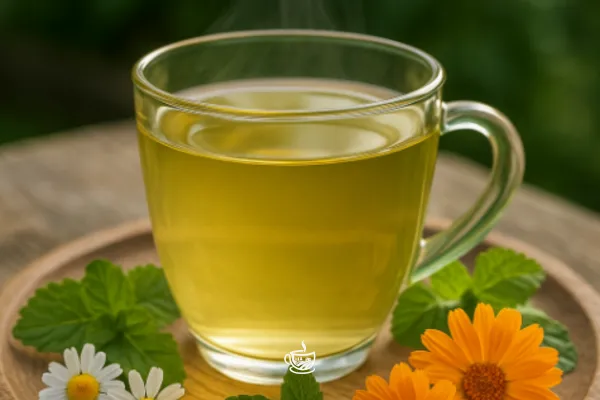
Anti-Inflammatory Teas You Can Grow Yourself (Zone 7b–8a Edition)
Sip your way to wellness—straight from your backyard. These powerhouse herbs make anti-inflammatory teas that grow well in Zones 7b–8a with a little love (and sometimes a pot!).
Healing in a Teacup (and in the Dirt)
You don’t need a pharmacy—or even a fancy health store—to brew anti-inflammatory tea. Many potent, soothing herbs grow beautifully in raised beds, garden guilds, or pots right outside your door here in Zone 7b/8a.
We are going deeper than the blogpost Tea and Digestion. Let’s explore the best inflammation-fighting plants that thrive in our climate—and how to dry and sip them with intention.
1. Turmeric (Curcuma longa)
Why: Curcumin is a potent anti-inflammatory compound
Zone Tips: Not frost-tolerant! Grow in pots; plant rhizomes after last frost and overwinter indoors. Likes rich, moist soil and heat.
Tea Tip: Grate fresh or dried root. Always pair with black pepper (it increases absorption) and add ginger for bonus warmth.
Pro tip: In the Summer, place it in a pot somewhere super hot, think: near a sunfacing building (thermal mass!). Tuck it into the heated shed come first frost.
2. Ginger (Zingiber officinale)
Why: Warming and stimulating, reduces inflammation and eases muscle aches
Zone Tips: Also frost-sensitive; grow in containers and bring indoors for winter. Plant in spring after last frost in part shade with compost-rich soil.
Tea Tip: Slice or grate into simmering water. Add lemon and honey for a post-weeding reward.
A go-to brew after pruning tea bushes? Ginger-lemon tea with raw honey. Reboots body and mood.
3. Chamomile (Matricaria chamomilla)
Why: Calms inflammation in the gut and nervous system
Zone Tips: Annual that reseeds easily. Loves sun and thrives in our spring and fall seasons.
Tea Tip: Dry flower heads fully before brewing for a mild, floral cup that soothes like a Southern grandmother’s hug.
4. Holy Basil / Tulsi (Ocimum tenuiflorum)
Why: Adaptogen and inflammation soother—great for stress-driven inflammation
Zone Tips: Treat like sweet basil. Start indoors or direct sow after frost. Grows easily in garden beds or pots with sun and regular pinching.
Tea Tip: Earthy and peppery. Use fresh or dried. Excellent with lemon balm.
5. Lemon Balm (Melissa officinalis)
Why: Mildly anti-inflammatory, calming, and digestive-friendly
Zone Tips: Hardy perennial in our climate! Cut back after flowering to keep it bushy. Grows well in raised beds or pots.
Tea Tip: Best fresh. Makes a gentle lemony infusion that blends well with tulsi or chamomile.
6. Calendula (Calendula officinalis)
Why: Fights inflammation, supports skin and lymphatic healing
Zone Tips: Annual but self-seeds in Zone 7b/8a (Which we love!!). Prefers full sun and average soil. Flowers from spring to frost.
Tea Tip: Dry the petals and steep with mint or chamomile for a bright, healing blend.
7. Peppermint (Mentha × piperita)
Why: Anti-inflammatory for gut health, relieves tension and headaches
Zone Tips: Perennial spreader—keep it in pots unless you want a mint jungle. Partial shade is fine.
Tea Tip: Great fresh or dried. Adds brightness to any blend.
Brew it daily after a communal lunch. It’s like hitting “reset” on your digestive system.
How to Harvest & Store in Zone 7b/8a
Harvest herbs in the morning once the dew dries but before the heat wilts their oils
Dry gently: Hang small bundles in shade or use a dehydrator
Store airtight: Use clean, labeled glass jars out of direct light somewhere cool (55-77 degree Temperature is ideal).
Use within 6–12 months for best potency
Pro tip: Label it like the future-you will forget. (Because she will.)
Final Sip
At Clemson Tea Farm, we’ve learned that our garden is more than a pantry—it’s a pharmacy, sanctuary, and teacher. These herbs are easy to grow in our climate (with a few winter workarounds) and help soothe inflammation in ways your body will thank you for.
Grow them generously. Harvest with reverence. Sip with intention.
Want to bring more farm-to-cup wellness into your life?
Join our newsletter for seasonal tea tips, health-forward recipes, and behind-the-scenes farm stories.
Or get on the waiting list for our small-batch tea harvest at Clemson Tea Farm—where every leaf tells a story.
There will also be the latest about upcoming tea classes, WWOOF volunteer opportunities, and hands-on events at Clemson Tea Farm. Whether you’re dreaming of growing your own tea or digging into the soil alongside us, we’d love to welcome you.
It’s not just a farm—it’s a classroom, a sanctuary, and sometimes a jungle gym for chickens. Come learn with us!
Wanna Read More?
Wanna Geek Out?
#AntiInflammatoryHerbs #GrowYourOwnTea #Zone7bGarden #Zone8aHerbs #HomegrownHealing #TisaneTime #ClemsonTeaFarm #BackyardPharmacy #HerbalRemediesFromTheGarden #FarmToCupWellness #TeaWithIntention #SipSootheRepeat #SouthernGardenHerbs #PeppermintAndPeace #ChamomileCalm #TurmericTips #GingerForTheWin #HolyBasilBlessings #CalendulaCare #LemonBalmLove
